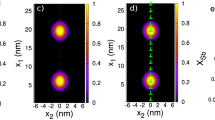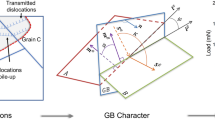Abstract
Dislocations in FCC structure are dissociated into two partial dislocations. The dissociation width of a dissociated dislocation controls the mechanical behavior of the alloy. Experimental work using transmission electron microscopy on factors determining the dissociation width is reviewed with special reference to the Suzuki segregation.































Similar content being viewed by others
Notes
It is noted that Frank’s notation indicates the way the two neighboring (111) planes are stacked. In other words, it indicates the environment of the two neighboring (111) planes. By contrast, this new notation indicates whether a (111) plane in consideration actually assumes FCC structure or HCP structure.
Term of apparent γ is used when it is not clear whether the value of γ under consideration is representative of the intrinsic value only or intrinsic + extrinsic value.
References
Heidenreich RD, Shockley W (1948) Study of slip in aluminium crystals by electron microscope and electron diffraction methods. In: Report of a conference on strength of solids, physical society, London, pp 57–75
Saka H, Sueki Y, Imura T (1978) On the intrinsic temperature dependence of the stacking-fault energy in copper-aluminium alloys. Philos Mag A 37(2):273–289
Cherns D, Hirsch P, Saka H (1980) Mechanism of climb of dissociated dislocations. Proc R Soc Lond A 371:213–234
Hirth JP, Lothe J (1968) Theory of dislocations. McGraw-Hill, New York, p 298
Kaneko Y (1994) Doctoral Dissertation, Nagoya University
Carter CB, Ray ILF (1977) On the stacking-fault energies of copper alloys. Philos Mag 35:189–200
Gallagher PC (1970) The influence of alloying, temperature, and related effects on the stacking fault energy. Met Trans 1:2429–2461
Carter CB (1975) Dissertation, University of Oxford
Ojima M, Adachi Y, Tomota Y, Katada Y, Kaneko Y, Kuroda K, Saka H (2009) Weak beam TEM study on stacking fault energy of high nitrogen steels. Steel Res Int 80:477–481
Yonezawa T, Suzuki K, Ooki S, Hashimoto A (2013) The effect of chemical composition and heat treatment conditions on stacking-fault energy for Fe-Cr-Ni austenitic stainless steel. Met Trans A 44:5884–5896
Saka H, Iwata T, Imura T (1978) Temperature dependence of the stacking-fault energy in pure silver. Philos Mag 37:291–296
Moon W-J, Umeda T, Saka H (2003) Temperature dependence of the stacking-fault energy in GaAs. Philos Mag Lett 83:233–240
Suzuki H (1952) Chemical interaction of solute atoms with dislocations. Sci Rep Res Inst Tohoku Univ A 4:455–463
Copley BM, Kear BH (1966) The dependence of the width of a dissociated dislocation on dislocation velocity. Acta Metal 16:227–231
Kestenbach H-J (1977) The effect of applied stress on partial dislocation separation and dislocation substructure in austenitic stainless steel. Phil Mag 36:1509–1515
Byun TS (2003) On the stress dependence of partial dislocation separation and deformation microstructure in austenitic stainless steels. Acta Mater 51:3063–3071
Pirouz P, Hazzledine PM (1991) Cross-slip and twinning in semiconductors. Scr Met 25:1167–1172
Cockayne DJH, Ray ILF, Whelan MJ (1969) Investigations of dislocation strain fields using weak beams. Philos Mag 20:1265–1270
Whelan MJ (1959) Dislocation interactions in face-centred cubic metals, with particular reference to stainless steel. Proc R Soc A 249:114–137
Steeds JE (1967) Calculations of the contrast of faulted dipoles and the measurement of stacking-fault energy. Philos Mag 16:785–803
Saka H (1980) The dislocation core cut-off parameter estimated from stacking-fault nodes in a Cu-Al alloy. Philos Mag A 42:185–194
Saka H (1984) Transmission electron microscopy of Suzuki segregation in fcc alloys. Res Mech 11:211–242
Lohne O (1973) Dislocation motion, reactions, and multiplication in a stressed aluminium single crystal. Phys Stat Solid 18:473–482
Saka H (1983) Weak-beam electron microscopy of radiation-induced segregation. Philos Mag A 48:239–250
Saka H, unpublished work
Saka H, Itoh K, Imura T, Kamino T (1987) Electron-microscope study of a non-stoichiometric phase in InSb heated in a vacuum. Philos Mag Lett 56:225–230
Saka H, Kondo T, Imura T (1983) The temperature dependence of the stacking-fault energy in silver-base alloys. Philos Mag A 47:859–868
Saka H (1983) Experimental evidence for Suzuki segregation to the stacking fault of an extended dislocation in a Cu-Si alloy. Philos Mag A 47:131–140
Saka H (1985) Transmission electron microscopy of Suzuki segregation in fcc alloys. In: Suzuki H, Ninomiya T, Sumino K, Takeuchi S (eds) Dislocations in solid. University Tokyo Press, Tokyo, pp 251–253
Howie A, Swann PR (1961) Direct measurement of stacking-fault energies from observations of dislocation nodes. Philos Mag 6:1215–1226
Kaneko Y, Kaneko K, Nohara A, Saka H (1995) Evidence for Suzuki effect in an Fe-Ni-Cr austenitic steel. Philos Mag A 71:399–407
Kamino T, Ueki Y, Hamajima H, Sasaki K, Kuroda K, Saka H (1992) Direct evidence for Suzuki segregation obtained by high-resolution analytical electron microscopy. Philos Mag Lett 66:27–31
Mendis BG, Jones IP, Smallman RE (2004) Suzuki segregation in a binary Cu-Si alloy. J Electron Microsc 53:311–323
Yang Z, Chisholm MF, Duscher G, Ma X, Pennycook SJ (2013) Direct observation of dislocation dissociation and Suzuki segregation in a Mg-Zn-Y alloy by aberration-corrected scanning transmission electron microscopy. Acta Mater 61:350–359
Saka H (2014) Long-term natural ageing of a dissociated dislocation in a Cu-13.43 at.% Al alloy. Philos Mag Lett 94:455–459
Smithhells CJ (1976) Metals reference book, 5th edn. Butterworths, London
Saka H, Iwata H, unpublished work
Loretto MH (1965) Experimental evidence for segregation to threefold nodes. Philos Mag 12:1087–1090
Rehn LR (1989) Irradiation-enhanced and -induced mass transport. Metall Trans A 20:2619–2626
Okamoto PR, Rehn LE (1979) Radiation-induced segregation in binary and ternary alloys. J Nucl Mater 83:2–23
Loretto MH, Smallmann RE (1975) Defect analysis in electron microscopy. Chapman and Hall, London, p 92
Saka H (1997) Kesshou-densikenbikyou-gaku (Electron microscopy of crystals). Uchidarokakuho, Tokyo
Cockayne DJH, Jenkins ML, Ray ILF (1971) The measurement of stacking-fault energies of pure face-centred cubic metals. Philos Mag 24:1383–1392
Author information
Authors and Affiliations
Corresponding author
Ethics declarations
Conflict of interest
The author declares that he has no conflict of interest.
Appendix practice of weak-beam dark-field (WBDF) technique
Appendix practice of weak-beam dark-field (WBDF) technique
In the normal bright-field (BF) or dark-field (DF) imaging, dislocation images have widths of typically >10.0 nm [41]. Under the WBDF technique, the detail observable is five to ten times finer than in normal two-beam conditions.
The practical procedures are as follows (Fig. 32a) [42].
Schematic diagram illustrating the change in the diffraction conditions for BF (a) and for WBDF [42] (b)
-
1.
First, in the BF mode, tilt a specimen so as to satisfy the Bragg condition for the reflection vector g. Kikuchi lines for g (the broad full lines) pass through the direct spot (0) and the spot of g.
-
2.
Next, switch to the DF mode and deflect the direct beam to the position of −g in the previous BF mode. At this stage, because the crystal is not tilted, the Kikuchi lines do not move, but the diffraction spots move and now 3g is excited instead of g (Fig. 32b).
This mode is called (g/3g) condition. Figure 33a, b shows examples of diffraction patterns in the BF and WBDF conditions, respectively.
Diffraction patterns in BF (a) and in WBDF in (g/3g) mode (b). Crosses show the optical axes. Objective aperture is to be inserted at the cross [42]
In this condition, the deviation parameter s g is given by
where |k| = 1/λ, n = 3 (because 3g is excited).
The actual separation of partial dislocations (Δ) is given from the experimental separation Δobs according to the equation proposed by Cockayne et al. [43].
where
and
\( {\mathbf{b}}_{\text{ie}}^{\text{p}} \) being the edge component of the ith partial and ν Poisson’s ratio.
It is noted that the Shockley partials are not always visible. Suppose that dissociated dislocation of b = 1/2[1\( \bar{1} \)0] is imaged in g = 2\( \overline{2} \)0. In this case, both partials 1 and 2 are visible because g. b = 1 for each partial (Fig. 34a). But in g = 0\( \bar{2} \)2 only partial 1 is visible (Fig. 34b) and in g = \( \bar{2} \)02 only partial 2 is visible (Fig. 34c).
Another important point is that caution must be paid to discriminate from a dipole. In a dissociated dislocation, one of the Shockley partials appears stronger than the other. In Fig. 35a, the upper partial is stronger than the lower partial. If imaged in −g (Fig. 35b) the reverse is true. On the other hand, in the case of a dipole, both of the two dislocations comprising the dipole are either strong or weak. In Fig. 36a, A and C appear weak, while B appears strong. On the other hand, in Fig. 36b, the reverse is true. Also, the separation of A is larger in Fig. 36a than in Fig. 36b.
This difference is explained using Fig. 37 [4, 42], which shows schematically the bending of lattices around individual Shockley partials of a dissociated dislocation (a, b) and the individual components of an edge dislocation dipole (c, d). The Burgers vectors b of the dislocation are defined according to FS/RH (perfect) convention, with the positive dislocation line direction (ζ) into the paper. Therefore, it is recommended to image the same dislocation in both +g and −g, to distinguish between a dissociated dislocation and a closely spaced dislocation dipole.
Rights and permissions
About this article
Cite this article
Saka, H. Factors affecting the dissociation width of dissociated dislocations in FCC metals and alloys. J Mater Sci 51, 405–424 (2016). https://doi.org/10.1007/s10853-015-9335-z
Received:
Accepted:
Published:
Issue Date:
DOI: https://doi.org/10.1007/s10853-015-9335-z










